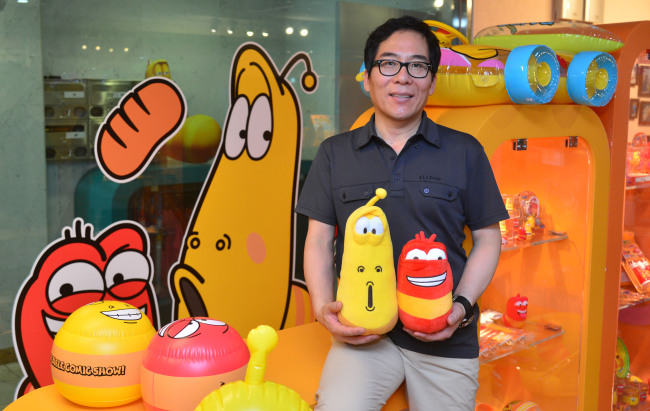Adventures of two larvae capture commuters’ hearts
Silent animated series transcends barriers of age, culture
By Lee Woo-youngPublished : Aug. 23, 2013 - 20:22
Two little brave larvae, Red and Yellow, embark on an adventure out into the world from the sewage drain in which they live.
They fly out of the sewer after turning into butterflies, but in the blink of an eye, they lose their wings in an airplane accident, and begin an urban adventure facing a series of dangers in a large metropolitan city.
Their tales of everyday survival play out continually in “Larva,” featured on screens in Seoul’s subway and buses.
“They make everyone laugh. It doesn’t target a specific generation group. It’s just for everyone because laughter is for everyone,” said Kim Kwang-yong, CEO of TUBAn, the animation studio behind the two famous characters born in 2011, in the interview with The Korea Herald on Monday.
The humor transcends generations, cultures and many languages.
The animation has been sold to 40 countries, mainly in Southeast Asia and Latin America.
They fly out of the sewer after turning into butterflies, but in the blink of an eye, they lose their wings in an airplane accident, and begin an urban adventure facing a series of dangers in a large metropolitan city.
Their tales of everyday survival play out continually in “Larva,” featured on screens in Seoul’s subway and buses.
“They make everyone laugh. It doesn’t target a specific generation group. It’s just for everyone because laughter is for everyone,” said Kim Kwang-yong, CEO of TUBAn, the animation studio behind the two famous characters born in 2011, in the interview with The Korea Herald on Monday.
The humor transcends generations, cultures and many languages.
The animation has been sold to 40 countries, mainly in Southeast Asia and Latin America.

“We received a great response at the Licensing Expo in Las Vegas in June. I was surprised because half of the contracts were made spontaneously on the spot,” Kim said.
Each short animation clip usually lasts 90 seconds (season 1) and three minutes (season 2) and has no dialogue. But the 90 seconds are enough to draw the attention of both Korean and global audiences.
“We made sure the episodes can be shared by anyone around the world. We check every episode to see whether it only applies to Korea, or to other countries as well. One episode featured a scene where a character has to pull out his tooth using a thread. We checked whether other cultures have the same experience,” said Kim.
Thanks to the big success in animation, there are around 700 products made through character licensing, ranging from kids’ backpacks and picture books to laptop cases for adults.
“There are now 70 different kinds of items produced through licensing and I expect the number of items is more than 30,000,” Kim said.
Some of the original licensed products were copied before the official launch in Malaysia because it first started to air in Southeast Asian countries.
The studio expects the merchandise and animation to bring in annual sales of 10 billion won ($8.9 million) at the end of the year, which is about six times the initial production cost of 1.5 billion won for season 1 made up of 104 episodes.
“Larva’s” success is a valuable lesson for the Korean animation and character industry as it is the first time characters have expanded the market from toddlers and children to adults.
“Most of the characters in Korea are aimed at three to four year olds. But our main target was teenagers and adults who use smartphones. We paid extra attention to the image quality and content. It turns out our main fan base is those in their 20s,” said Kim.
Kim noted good content had a higher chance of getting attention without much PR or advertising cost because of new media platforms such as YouTube and public screens.
“There are many ways to promote good content. “Larva” was lucky in that respect. It gave us a new opportunity for us to compete with global animation studios,” said Kim.
By Lee Woo-young (wylee@heraldcorp.com)







![[Graphic News] More Koreans say they plan long-distance trips this year](http://res.heraldm.com/phpwas/restmb_idxmake.php?idx=644&simg=/content/image/2024/04/17/20240417050828_0.gif&u=)
![[KH Explains] Hyundai's full hybrid edge to pay off amid slow transition to pure EVs](http://res.heraldm.com/phpwas/restmb_idxmake.php?idx=644&simg=/content/image/2024/04/18/20240418050645_0.jpg&u=20240419100350)





![[From the Scene] Monks, Buddhists hail return of remains of Buddhas](http://res.heraldm.com/phpwas/restmb_idxmake.php?idx=652&simg=/content/image/2024/04/19/20240419050617_0.jpg&u=20240419175937)

![[KH Explains] Hyundai's full hybrid edge to pay off amid slow transition to pure EVs](http://res.heraldm.com/phpwas/restmb_idxmake.php?idx=652&simg=/content/image/2024/04/18/20240418050645_0.jpg&u=20240419100350)

![[Today’s K-pop] Illit drops debut single remix](http://res.heraldm.com/phpwas/restmb_idxmake.php?idx=642&simg=/content/image/2024/04/19/20240419050612_0.jpg&u=)